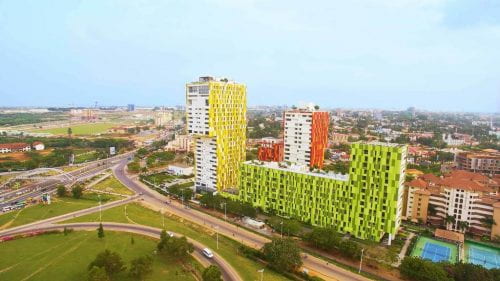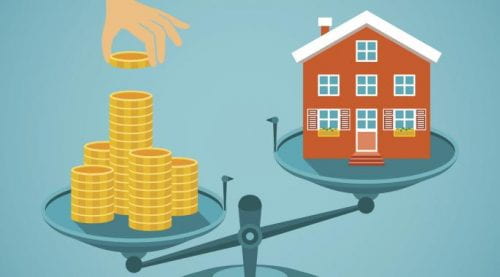 Ghana’s housing crisis is intensifying as the housing affordability bracket of the growing demand is below the average market price point. The challenges posed by the growing demand are predominantly driven by the inability to lease a home or access credit to acquire a home. Though in recent years the Government of Ghana has begun to explore ways to make mortgages more accessible to the populace, the hurdle has been how to determine eligibility for affordable housing credit while mitigating risks of defaults 1.
Ghana’s housing crisis is intensifying as the housing affordability bracket of the growing demand is below the average market price point. The challenges posed by the growing demand are predominantly driven by the inability to lease a home or access credit to acquire a home. Though in recent years the Government of Ghana has begun to explore ways to make mortgages more accessible to the populace, the hurdle has been how to determine eligibility for affordable housing credit while mitigating risks of defaults 1.
In most countries in Europe and the Americas, household income is the primary determinant for eligibility2. Other social and demographic factors may also be considered, such as household size, number of dependents, and employment history2. As these factors of eligibility will equally apply to Ghana, there is a cultural nuance that stems from the orientation of the family system. With the innate Ghanaian desire to be close to one’s family, it is a normal phenomenon to have more than two family generations living under one roof. In recent times, this multi-generational method of living has also become a cheaper housing alternative, due to the challenges being experienced with housing affordability1. In the last decade (2009 – 2019), there have been efforts made by the government to reduce the effects of crowded households by increasing the housing supply through government-funded social housing projects like the Social Security and National Insurance Trust (SSNIT) Affordable Housing in Borteyman, Accra and Tema Housing Development (TDC)Housing in Tema, Accra. A structured system of eligibility, access to affordable financing, and a monitoring mechanism are required to ensure that these strategies reach their intended beneficiaries. In their absence, the Government of Ghana often ends up subsidizing home prices for people in a higher income bracket rather than the intended beneficiaries. In lieu of the traditional model, several creative and inclusive approaches in which the public sector in collaboration with the private sector can address the challenges with affordable housing financing are as follows:
Government-Supported or Guaranteed Loan Programmes
In 2019, the Government of Ghana launched a GH₵ 1 billion($170M) housing fund targeted at low-income earner’s mortgages with an LTV of 90%3. However, the challenge with determining eligibility has resulted in undue delays in executing the program. While household income is the primary determinant for eligibility in most countries using a targeted approach, in the case of Ghana, other social, cultural, and demographic factors may also be considered, such as household size, number of generations, age, and prior asset ownership.
Akin to other affordable homeownership programs in the US and UK, the government typically aids with both the down payment and mortgage2. As such, the Ghanaian government should create and implement a loan program where low-income earners may be provided with further “Below Market Rate” loan assistance to cover the cost of the required down payment4.
Crowdfunding Credit to Buy Homes
Before the introduction of a formalized saving and loan system through banking in Ghana and across Africa, a prior system existed called “Susu”. A Susu is a form of rotating savings and credit association; a type of informal savings club arrangement between a small group of people who are usually living in the same community or operate similar businesses or trades5. The basic principle is that each member of the group makes a standard contribution to a common fund once each pre-determined period. Then each period the total contributions are disbursed to a single member of the group. The recipient changes each period in a rotating fashion such that all the members of the group are eventually recipients5. Participants of a Susu do not make a profit but receive their contributions as a lump sum. In recent times, though the formal banking system has become the order of the day, the Susu remains the most accessible and lowest cost approach to raising funds within the low to middle-income earners bracket. Historically, this capital-raising approach has proven to be the best financing option for land acquisition4. Leveraging this existing social construct, grounded in communal trust and accountability, a system could be created where a group of potential home buyers can crowdsource capital from each other over a period to facilitate a decent home purchase. This approach comes at a zero percent interest rate to all the participants in a complete rotation cycle and the acquired homes can be held as collateral until the rotational cycle is completed.
Creditworthiness and Risk of Default in the Informal Sector
Over 70% of the Ghanaian working population are in the informal sector, most of whom are low to middle-income earners7. The informal sector is usually at the peril of bad macroeconomic and political decisions and such cashflows/income in the sector can be erratic7. As a result, banks and lending institutions find it complicated to underwrite housing financing loans to Ghanaians in the informal sectors and would rather not offer any product to them7. Local governments can help strengthen credit assessment and risk management by guaranteeing some loans of their residents, through various measures. So can Telecommunication companies; MTN, Vodafone, and Airtel-Tigo, for example, use data, such as merchant transactions from the mobile money services, to decide on an applicant’s creditworthiness. This makes conventional mortgages more accessible to low to middle-income earners who fall within the informal sector.
Addressing the 1.8 million affordable housing deficits in Ghana does not only require increasing housing supply but also a broader understanding of what constitutes affordability and the factors that affect it. The designed inventions need a multi-stakeholder environment that stimulates housing demand while increasing housing supply. The local and federal government, private sector, and civil society must act with urgency to address affordability if they want to avoid the rapid growth of slums and generational poverty. The aforementioned strategic interventions and long-term reforms can reduce dependence on government support systems and incentivize more commercially viable affordable housing projects for both local and international developers and investors.
End Notes
- Teye J, Teye I & Asiedu M. (2013, October 27). Financing housing in Ghana: challenges to the development of formal mortgage system. Retrieved April 19, 2021, from https://center4affordablehousing.org/wp-content/uploads/2019/02/UPLOADED_Kofi-2012-Mortgage-Finance-in-Ghana.pdf
- World Economic Outlook ( 2019, June). Making Affordable Housing a Reality in Cities. Retrieved April 19, 2021, from http://www3.weforum.org/docs/WEF_Making_Affordable_Housing_A_Reality_In_Cities_report.pdf
- Ministry of Finance, Government of Ghana (2019, December 30). National Housing and Mortgage Fund (NHMF) Survey. Retrieved April 19, 2021, from https://mofep.gov.gh/news-and-events/2019-12-30/national-housing-and-mortgage-fund-nhmf-survey
- Oxford Business Group. (2012). Home loans: A strong long-term outlook for the mortgage sector. Retrieved April 19, 2021, from http://www.oxfordbusinessgroup.com/news/home-loans-strong-long-term-outlook-mortgage-sector
- Abramsky, Sasha (October 22, 2000). “Newcomers Savings and Loan”. New York Times. p. CY4. Retrieved April 19, 2021, from https://www.nytimes.com/2000/10/22/nyregion/new-yorkers-co-newcomers-savings-and-loan.html
- International Labour Office, Geneva (2018). Women And Men In The Informal Economy: A Statistical Picture. Retrieved April 19, 2021, from https://www.ilo.org/wcmsp5/groups/public/—dgreports/—dcomm/documents/publication/wcms_626831.pdf
- Dennis P. O. Quansah and Akua A. Debrah (2015, November 5). Sustainable Housing Finance in Ghana: The Way Forward. Retrieved April 19, 2021, from file:///C:/Users/DELL/Downloads/SustainableHousingFinanceinGhana2.pdf


